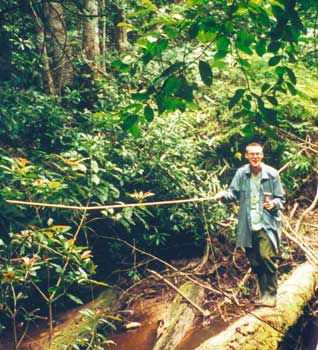Interspecific
competition among Cercopithecus campbelli, Cercopithecus petaurista and Cercopithecus diana at Tai Forest,
Cote d'Ivoire
My dissertation focused on the community ecology of forest
guenons (Ceropithecus
spp.) in the Tai Forest, Cote d'Ívoire. I collected
data on diet, range use, and cheek pouch use, and related variables
derived from these data to seasonal variation in resource abundance and
participation in mixed-species groups. To measure competition, I
assessed population densities and social systems. I also measured
ecological partioning in and out of association, ranging patterns,
agonistic rates and cheek pouch use in relation to food availability.
C. diana was competitively superior to the other species. C. campbelli
was more affected by competition with C. diana than was C. petaurista.
Each species was at a similar group density but C. diana formed larger
groups. C. petaurista diverged from the other species mainly by
consuming more foliage while C. diana and C. campbelli mostl ate fruit
and differed from each other primariliy in the canopy strata used, with
C. diana using higher strata than C. campbelli. C. diana/C. campbelli
overlapped the most in food items and diverged the most (in diet) in
the eason of fruit scarcity. C. diana/C. campbelli age/sex classes also
overlapped the most of any species pair. The study species spent 60-90%
of their time in association with each other. Niche shifts in
association were not great and association was not related to fruit
availability. Ranging patterns were very similar and did not change in
relation to food availability or fruit consumption. C. campbelli
received the most aggression from C. diana and C. campbelli used cheek
pouches the most overall and in the season with the most aggression.
Cheek pouch use was not positively related, howver, to association with
C. diana.
The results indicated that competition was less important among the
study species than for other guenon communities. A high predator risk
was demonstrated in this community, and I discussed the importance of
predator risk and adaptations to reduce predation as structuring
factors in this community.
Publications from the dissertation:
- Buzzard, P.J. (2010). Polyspecific associations of Cercopithecus campbelli and C. petaurista with C. diana: what are the costs and benefits? Primates 51: 307-314.
- Buzzard, P.J. and
Eckardt, W. (2007). Social systems of the Taï guenons (Cercopithecus spp.). In: Monkeys of the Taï Forest: An African
Primate Community eds.
K. Zuberbühler, S. McGraw, and R. Noë. Cambridge University
Press.
- Buzzard, P.J. (2006).
Cheek pouch use in relation to interspecific competition and predator
risk in three guenon monkeys (Cercopithecus
spp.). Primates 47: 336-341.
- Buzzard, P.J.
(2006). Ecological partitioning of Cercopithecus campbelli, C. petaurista
and C. diana in the Taï
Forest. International Journal
Primatology 27: 529-558.
- Buzzard, P.J. (2006).
Ranging patterns in relation to seasonality and frugivory among Cercopithecus campbelli, C.
petaurista, and C. diana
in the Taï Forest. International
Journal Primatology 27(2): 559-573.
Paul is now Director of Conservation at the Detroit Zoo.

